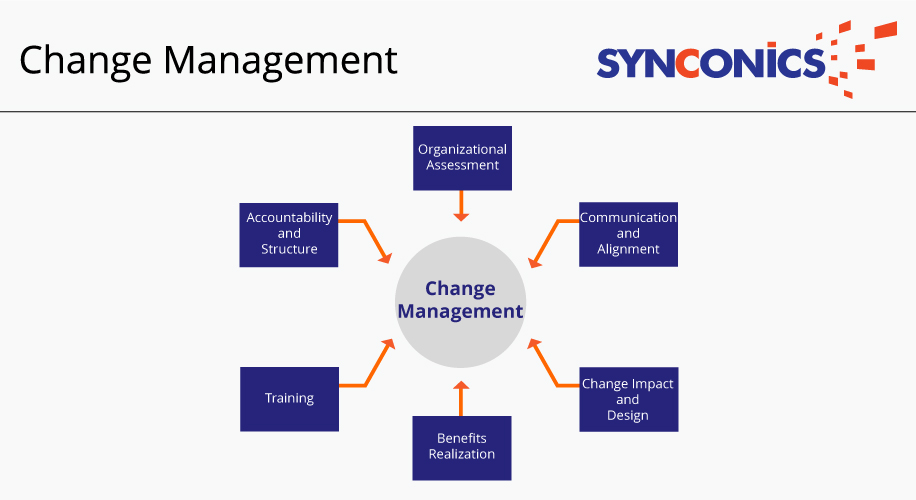Change Management in ERP Implementation
Changing With the Times: All in all, an ERP selection is a chance for a manufacturer to “change with the times” and apply the needed resources for the implementation to make lasting business change.
When looking at ERP and change management, the goal is to eliminate waste, improve productivity, optimize existing resources, handle growth without adding resources, and streamline existing operations. A company can’t expect the ERP vendor to take on this responsibility. The right approach to the team, the resources, and organizational commitment helps insure that staff can function as “change agents” within the company as opposed to those that block or resist.
ERP consultants are often asked to explain what organizational change management (OCM) is and how it relates to enterprise software initiatives. In short, organizational change management is the practice of shepherding and supporting individuals through a transformative operational change.

Because an Odoo implementation affects, in some way or another, nearly every staff member of a company, an organizational change management plan must make provisions for every staff member. A solid strategy also takes into account external stakeholders — the vendors, customers, suppliers, shareholders and others who work with or provide support to the company. Similar to employees, these individuals need to know what’s happening, why it’s happening and what the short-term and long-term effects of it will be.
ERP are made to flexibilize the enterprise and the management of the internal processes. What is Enterprise Resource Planning and why ERP is related to Change? At first we must make it clear that when we are talking about ERP, we mean the Enterprise Resource Planning solutions which are really following the concepts and characteristics of ERP. Enterprise Resource Planning is not only a technology that automates the processes of the organizations but is a solution to run the business more efficient and beneficial. That means implementing a world class Enterprise Resource Planning involves not only with changes in the technical layer of the organization but also changes in the mission layer of the organization.
This happens mainly due to the Best Practices which Enterprise Resource Planning solutions offer. Best Practices refer to the business models which are stored as work flow engine and the logic of programs in ERP package. Such models are made thorough benchmarking from the practices and business processes of the world class organizations and excellent enterprises. So when an organization uses such ERP solutions, in fact it employs these Business reference models.
Thus, Enterprise Resource Planning implementation is equivalent to running the business as per new processes and practices. On the other hand the employees of the organization should change to work on a new practice. This exposes why ERP is tied with change in the organization and organizational change must be considered as a consequence of such Enterprise Resource Planning implementation. What areas will undergo change? The change as told begins from the business processes. This includes new way of doing works and functions to run the business. Furthermore change in the attitude to the organization tasks might become necessary if the current habits of doing tasks have significant gaps with the new processes.
The ERP change management plan should provide a detailed, actionable roadmap to the desired future state. We advocate a planning approach similar to the one used for business process mapping. Specifically, the change management plan should be based on an analysis of the gaps between the “As Is” and “To Be” environments. Given time, cost and geographic constraints, the path to change should also be the shortest, most surgically-precise path. A change management plan should contain, at a minimum, the following components:
Executive Buy-in: Make sure that you have buy-in from leadership in every office and region. While employees may report to the home office, their allegiance lies where their leadership resides. If you don’t have buy-in from everyone in leadership, your ERP project will not be successful.
Cultural considerations: Language, education and demographic differences have a significant impact on how employees perceive and understand goals, objectives, risks and benefits of an ERP project.
Employee engagement: Organizational readiness assessments are critical with global ERP projects to ensure all issues and opportunities are captured across the enterprise. While this is an area that is often omitted for budget reasons, the added expense required for engaging and involving employees leads to quantifiable benefits realization in the long run.
Communications: Communication within a global ERP project is absolutely vital but incredibly difficult. While email is very effective, there are other nuances that need to be accounted for. For instance, most employees would like to hear updates about the project from their manager during team meetings. Project and communications teams must have a plan for how they will provide updates and coach managers on how to best deliver the messages to their teams. Again, language, culture and level of education among end-users has a significant influence on messaging.
Training: Change management plans must be devised in order to address workforce transition to the new ERP system and who will be super-users and trainers. A comprehensive training strategy should account for local nuances, locations and testing prior to go-live. Failing to fully develop a training strategy can have serious implications on the success of a global ERP implementation.